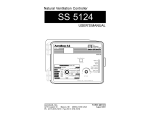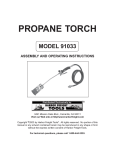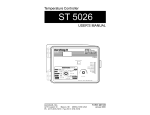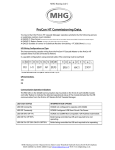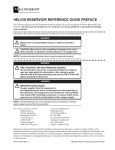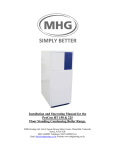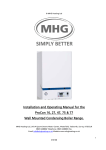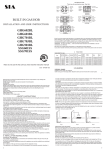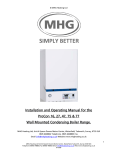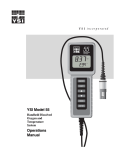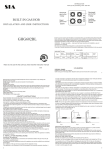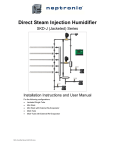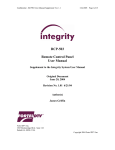Download TC4-NVS - Farmer Boy Ag Systems
Transcript
Environment Control TC4-NVS USER'S MANUAL TABLE OF CONTENTS Page PRECAUTIONS .............................................................. 3 FEATURES ..................................................................... 4 LOCATION OF THE CONTROLS ................................... 6 FACTORY SETTINGS .................................................... 9 INSTALLATION .............................................................. 10 Mounting Instructions ..................................................... 10 Connections .................................................................. 10 Temperature Probes ..................................................... 11 CONFIGURATIONS ........................................................ 13 CHANGING THE PARAMETER SETTINGS .................. 16 The Meaning of a Flashing Display ................................ 16 Locking the Parameters ................................................ 16 ADJUSTING THE TEMPERATURE ............................... 17 Temperature Units ........................................................ 17 Viewing Temperatures .................................................. 17 Temperature Set Point .................................................. 18 Temperature Curve ....................................................... 19 CURTAINS ...................................................................... 23 Principle of Operation ................................................... 23 Curtain Operating Time Compensation ......................... 25 COOLING AND MIST SETTINGS ................................... 28 Minimum Ventilation Cycle ............................................ 28 Mist Timer ..................................................................... 28 HEATER SETTINGS....................................................... 31 TROUBLESHOOTING GUIDE........................................ 33 ALARM SETTINGS ......................................................... 34 TECHNICAL SPECIFICATIONS .................................... 37 2 TC4-NVS.rev.03 PRECAUTIONS We strongly recommend installing supplementary natural ventilation as well as a back-up thermostat on stage 2 (refer to the wiring diagram enclosed with this user's manual to connect the thermostat) as well as an independent failure alarm system and a curtain drop or manual winch. Although fuses at the input and outputs of the controller protect its circuits in case of an overload or overvoltage, we recommend installing an additional protection device on the controller's supply circuit as well as an external relay on stage 2 to prolong the life of the controller. The room temperature where the controller is located MUST ALWAYS REMAIN BETWEEN 32°F AND 104°F (0°C TO 40°C). To avoid exposing the controller to harmful gases or excessive humidity, it is preferable to install it in a corridor. DO NOT SPRAY WATER ON THE CONTROLLER FOR CUSTOMER USE Enter the serial number located on the side of the controller below for future reference. Model number: TC4-NVS Serial number: TC4-NVS.rev.03 3 FEATURES The TC4-NVS is an electronic device used for environmental control in livestock buildings and greenhouses. It allows the user to maintain a specified target temperature by controlling the operation of ventilation and heating equipment. One stage of either constant-speed fans, heating units or mist sprinklers, as well as curtains for natural ventilation, can be connected to the controller. The main features of the TC4-NVS are as follows: THREE-DIGIT DISPLAY A three-digit display provides a high level of accuracy, allowing the user to specify a temperature to within one tenth of a degree (in Fahrenheit or Celsius units). PILOT LIGHTS INDICATING STATE OF OUTPUTS Pilot lights indicating the state of outputs allow the user to monitor the operation of the system without having to enter the building. MINIMUM VENTILATION CYCLE When ventilation is not required for cooling, the first stage fans can be operated either continously or intermittently to reduce the level of humidity and supply oxygen to the room. TEMPERATURE CURVE The controller can be set to automatically change the temperature set point over a given period of time in accordance with the user's requirements by specifying a temperature curve with up to six different points. FOUR INDEPENDENT TEMPERATURE PROBE INPUTS Up to four temperature probes can be connected to the controller in order to obtain a more accurate reading of the average room temperature and a faster reaction time. 4 TC4-NVS.rev.03 TC4-NVS HIGH/LOW TEMPERATURE AND POWER FAILURE ALARMS The controller generates an output signal that will activate any alarm system in case of a rise or fall in temperature beyond a specified limit, a power failure or a fault in the supply circuit. ROOM TEMPERATURE COMPENSATION ON CURTAINS The controller compensates the curtain timer settings proportionally to room temperature. The lower the temperature, the faster the curtains close. The higher the temperature, the faster the curtains open. OVERLOAD AND OVERVOLTAGE PROTECTION Fuses are installed at the input and outputs of the controller to protect its circuitry in the case of an overload or overvoltage. COMPUTER CONTROL The controller can be connected to a computer, thus making it possible to centralize the management of information and diversify control strategies. ADAPTS TO ALL TYPES OF AIR INLET POWER UNITS TC4-NVS.rev.03 5 6 TC4-NVS.rev.03 LOCKED ALARM DEF. PROBE T CURVE STAGE 2 CLOS ING NATURAL VENTILATIO N CON TR OLLER OPENING LOCATION OF THE CONTROLS TC4-NVS 1 Three-Digit Display Displays temperatures and other parameters shown on the Adjustment Knob. 2 Curtain Opening Pilot Light Turns on when the curtains open. 3 Curtain Closing Pilot Light Turns on when the curtains close. 4 Stage 2 Pilot Light Turns on when Stage 2 fans, heaters or mist units are on. 5 Temperature Curve Pilot Light Turns on when the temperature curve is activated. 6 Defective Probe Pilot Light Turns on when a defective probe is detected. 7 Alarm Pilot Light Turns on when the alarm is activated. 8 Locked Parameter Pilot Light Turns on when the parameters are locked. 9 Push-Button for Other Functions Used to access other functions such as specifying the points of a temperature curve. 10 Parameter Selection Knob Used to select a parameter. 11 Adjustment Knob Used to adjust the value of a selected parameter. TC4-NVS.rev.03 7 TC4-NVS 12 Internal Switches The internal switches are located on the inside of the front cover and are defined as follows: # 1 OFF ON UNLOC KED PARAMETERS LOC KED PARAMETERS 2 FAHRENHEIT D EGREES C ELSIUS D EGREES 3 PROBE 2 D ISABLED PROBE 2 ENABLED 4 PROBE 3 D ISABLED PROBE 3 ENABLED 5 PROBE 4 D ISABLED PROBE 4 ENABLED 6 STAGE 2 C OOLING STAGE 2 HEATING 7 NORMAL MOD E PROGRESSIVE MOD E 8 STAGE 2 VENT. STAGE 2 MIST NOTE : When the controller is shipped from the factory, all the switches are set to OFF. 8 TC4-NVS.rev.03 FACTORY SETTINGS PAR AME T E R Temperature Set Poi nt Temperature C urvea Ti me Openi ng FAC TORY SETTIN GS 75 o F (23.9 oC ) OFF R AN GE OF VALU ES -40 to 99.9 oF (-40 to 37.7 oC ) days < 100 20 seconds 1 to 900 seconds Ti me C losi ng 20 seconds Ti me Off 60 seconds 0 to 900 seconds D i fferenti al 3 oF (1.7 oC ) 0.5 to 20 oF (0.3 to 11.1 oC ) Hi gh offset 12.0oF (6.7oC ) 0.5 to 40.0 oF (0.3 to 22.0 oC ) Low offset 10.0oF (5.6oC ) 0.5 to 40.0 oF (0.3 to 22.0 oC ) Offset 2.0 oF (1.1 oC ) -9.9 to 20 oF (-5.5 to 11.1 oC ) C urtai ns Alarm Ti me On Stage 2 C ooli ng or Ti me Off Heati ng D i fferenti al 15 seconds 30 seconds 2.0 oF (1.1 oC ) 0 to 900 seconds 1 to 60 mi nutes (mi st only) 0.5 to 20 oF (0.3 to 11.1 oC ) NOTES : i) These initial parameter settings will not be retained in the controller's memory. Each new setting will replace the preceeding one. ii) If the power supply is cut off, the last parameter settings will be retained in memory until the power is restored. (a) The range of values for curve temperatures is 35°F to 99.9°F (1.7°C to 37.7°C). TC4-NVS.rev.03 9 INSTALLATION MOUNTING INSTRUCTIONS Remove the four screws on the front cover and lift the cover. Mount the enclosure on the wall using three screws. Be sure the electrical knockouts are at the bottom of the enclosure in order to prevent water from entering the controller. Insert the screws in the mounting holes provided in three corners of the enclosure and tighten. Fasten the three black caps provided with the controller onto the three mounting holes. CONNECTIONS To connect the controller, refer to the wiring diagram enclosed with this user's manual. ð Set the voltage switch to the appropriate voltage. ð Use the electrical knockouts provided at the bottom of the enclosure. Do not make additional holes in the enclosure, particularly on the side of the enclosure when using a computer communications module. ð If Stages 2 is used for heating, it may be necessary to install a transformer in order to supply the appropriate voltage to the heating unit. CONCERNING THE ALARM CONNECTION: There are two types of alarms in the industry. One type activates when current is cut off at its input, whereas the other activates when current is supplied at its input. For an alarm of the first type, use the NO terminal as shown in the wiring diagram. For an alarm of the second type, use the NC terminal. 10 TC4-NVS.rev.03 TC4-NVS ! WARNING ALL WIRING MUST BE DONE BY AN AUTHORIZED ELECTRICIAN AND MUST COMPLY WITH APPLICABLE CODES, LAWS AND REGULATIONS. BE SURE POWER IS OFF BEFORE DOING ANY WIRING TO AVOID ELECTRICAL SHOCKS AND EQUIPMENT DAMAGE. TEMPERATURE PROBES 1 Connecting the Probes The controller is supplied with one temperature probe connected to terminal # 1. Three additional indoor probes can be connected to improve accuracy and reaction times. ð Use terminals # 2, 3 and 4 to connect additional indoor probes, as shown on the wiring diagram enclosed. Switches are used to activate or deactivate the additional probes connected to the controller. Activate each additional probe by setting the appropriate switch to ON: ð ð ð Switch # 3 activates the probe connected to terminal # 2. Switch # 4 activates the probe connected to terminal # 3. Switch # 5 activates the probe connected to terminal # 4. CAUTION: Probes operate at low voltage and are insulated from the supply. Be sure that probe cables remain insulated from all high voltage sources. In particular, do not route the probe cables through the same electrical knockout as other cables. Do not connect the shield from the probe cable to a terminal or a ground. TC4-NVS.rev.03 11 TC4-NVS 2 Extending the Probes Each probe can be extended up to 500 feet (150 m): ð Use a shielded cable of outside diameter between 0.245 and 0.260 in (6.22 and 6.60 mm) to ensure the cable entry is liquid tight (cable dimensions should not be under 18 AWG). Do not ground the shielding. ð It is preferable to solder the cable joint to ensure a proper contact between the two cables. CAUTION: Do not run probe cables next to other power cables. When crossing over other cables, cross at 90o. 3 Detecting Faulty Probes If a faulty probe is detected, the Defective Probe pilot light turns on. The room temperature shown on the display is then the average temperature measured by the probes in working condition. The controller will operate according to this temperature. To identify the faulty probe: ð Set the selection knob to AMBIENT. The room temperature is displayed. ð Press the push-button. If the probe connected to terminal # 1 is not faulty, "Pr 1" is displayed, alternating with the temperature measured by the probe. Otherwise, "Pr 1" alternates with "P". ð Keep pressing the push-button to view the status of the other probes. NOTE: If all the probes are defective, the controller operates the cooling stages in minimum ventilation mode. 12 TC4-NVS.rev.03 CONFIGURATIONS STAGE 2 — HEATING ON12345 12345 12345 12345 12345 12345 12345 12345 12345 12345 12345 12345 12345 12345 12345 12345 12345 12345 12345 12345 12345 12345 12345 12345 12345 12345 12345 12345 12345 12345 12345 12345 12345 12345 12345 1 2 3 4 5 6 12345 12345 12345 12345 12345 12345 12345 12345 12345 12345 12345 12345 12345 12345 7 8 Operation Heater Heater units turn on Heater units turn off Diff. Offset Temperature Set Point Temperature rises: When the temperature rises to Set Point - Offset, the heater units turn off. At Set Point + Diff. 1, the curtains begin to open intermittently according to the curtain timer settings. Temperature falls: When the temperature falls to Set Point - Diff. 1, the curtains begin to close intermittently according to the curtain timer settings. At Set Point - Offset - Diff., the heater units turn on. Note: Heating units do not operate with the timer. TC4-NVS.rev.03 13 TC4-NVS STAGE 2 — VENTILATION COOLING 12345 ON12345 12345 12345 12345 12345 12345 12345 12345 12345 12345 12345 12345 12345 12345 12345 12345 12345 12345 12345 12345 12345 12345 12345 12345 12345 12345 12345 12345 12345 12345 12345 12345 12345 12345 1 2 3 4 5 12345 12345 12345 12345 12345 12345 12345 6 7 8 Ventilation Stage 2 Stage 2 fans stop running Offset Stage 2 fans start running Diff. Temperature Set Point Temperature rises: When the temperature rises to Set Point + Diff. 1, the curtains begin to open intermittently according to the curtain timer settings. At Set Point + Offset + Diff., the Stage 2 fans start to run. Temperature falls: When the temperature falls Set Point + Offset, the Stage 2 fans stop running. At Set Point - Diff. 1, the curtains begin to close intermittently according to the curtain timer settings. 14 TC4-NVS.rev.03 TC4-NVS STAGE 2 — MIST COOLING 12345 ON12345 12345 12345 12345 12345 12345 12345 12345 12345 12345 12345 12345 12345 12345 12345 12345 12345 12345 12345 12345 12345 12345 12345 12345 12345 12345 12345 12345 12345 12345 12345 12345 12345 12345 1 2 3 4 5 12345 12345 12345 12345 12345 12345 12345 6 7 8 Operation Stage 2 Stage 2 mist starts running Stage 2 mist stops running Offset Diff. Temperature Set Point Temperature rises: When the temperature rises to Set Point + Diff. 1, the curtains begin to open intermittently according to the curtain timer settings. At Set Point + Offset + Diff., the Stage 2 mist units start to run according to the timer 2 settings. Temperature falls: When the temperature falls to Set Point + Offset, the Stage 2 mist units stop running. At Set Point - Diff. 1, the curtains begin to close intermittently according to the curtain timer settings. NOTE: The mist timer operates in minutes (1 to 60 minutes). TC4-NVS.rev.03 15 CHANGING THE PARAMETER SETTINGS THE MEANING OF A FLASHING DISPLAY The display will flash in certain cases and not in others. The flashing indicates that the value shown can be adjusted. A value that is not flashing cannot be adjusted. LOCKING THE PARAMETER SETTINGS The parameter settings can be locked to prevent accidentally modifying them. When the settings are locked, only the temperature set point can be modified (as long as the temperature curve is deactivated). To lock the parameter settings: ð Set internal switch # 1 to ON. The Locked Parameter Pilot Light turns on. To unlock the parameter settings: ð Set internal switch # 1 to OFF. The Locked Parameter Pilot Light turns off. 16 TC4-NVS.rev.03 ADJUSTING THE TEMPERATURE TEMPERATURE UNITS Temperatures can be displayed in either Celsius or Fahrenheit units ð Set internal switch # 2 to the desired position: ON • ON to display temperatures in Celsius units. • OFF to display temperatures in Fahrenheit units. 2 VIEWING TEMPERATURES The readout can display values from -40.0oF to 120.0oF (-40.0oC to 48.9oC). When the temperature drops below -9.9 degrees, the negative sign is displayed separately, alternating with the numerical value. 1 Viewing the Room Temperature The room temperature is the average value of all temperatures measured by activated probes in proper operating condition. ð Set the selection knob to AMBIENT. The room temperature is displayed. 2 Viewing Probe Temperatures The controller can display probe temperatures individually. Probes can also be turned on or off to control the temperature in different parts of the building by using internal switches # 3, 4 and 5. ð Set the selection knob to AMBIENT. The room temperature is displayed. ð Press the push-button. "Pr 1" is displayed, alternating with the temperature measured by the probe connected to terminal # 1 (supplied with the controller). TC4-NVS.rev.03 17 TC4-NVS ð Press the push-button once again to display the temperature, etc. 3 Viewing Minimum / Maximum Temperatures The minimum and maximum temperatures are the lowest and highest temperature values recorded since the last reset. Temperatures values are averaged over all active probes. ð Set the selection knob to AMBIENT. The room temperature is displayed. ð Turn the adjustment knob clockwise by one notch. The minimum temperature flashes on the display. ð Turn the adjustment knob counterclockwise one notch. The maximum temperature flashes on the display. NOTE: If you let the display flash for more than 10 seconds, the controller resets the minimum and maximum temperatures currently in memory (the display stops flashing to indicate that the reset has been done). TEMPERATURE SET POINT The temperature set point is the target room temperature. It can be adjusted between -40.0°F and 99.9°F (-40.0°C and 37.7°C). 1 Adjusting the Temperature Set Point ð Set the selection knob to SET POINT / TEMP. CURVE.The current set point flashes on the display. ð Use the adjustment knob to adjust the set point to the desired value. 18 TC4-NVS.rev.03 TC4-NVS NOTE: The temperature set point can be adjusted only if the temperature curve is deactivated (see following section). TEMPERATURE CURVE The user can define a temperature curve to adjust the set point automatically over a given time period. A curve is defined using six points. Each point specifies a day number and a set point for that day. Once the points of the curve are defined, the curve must be activated. The controller will change the temperature set point every hour in a linear fashion between consecutive points of the curve. When the last point of the curve is reached, the temperature set point for that day is maintained until the curve is reactivated. NOTES : i) All six points of the curve must be specified. If six points are not needed, repeat the last temperature value for each unnecessary point. ii) Certain restrictions apply to reduce the risk of errors: − The highest possible day number is 99. − Decreasing day numbers are not allowed. − Increasing temperatures are not allowed. − The temperature variation cannot exceed 3°F (1.6°C) per day. ○ ○ ○ ○ ○ ○ ○ ○ ○ ○ ○ ○ ○ ○ d35 d50 d70 ○ ○ ○ ○ ○ ○ ○ ○ ○ ○ ○ d25 ○ ○ ○ ○ ○ ○ ○ d4 ○ ○ ○ ○ ○ ○ ○ ○ ○ T o1 T o2 T o3 T o4 T o5 T o6 ○ Temperature d80 Days TC4-NVS.rev.03 19 TC4-NVS 1 Specifying the Temperature Curve ð Set the selection knob to SET POINT /TEMP. CURVE. The current temperature set point flashes on the display. ð Press the push-button. The word OFF is displayed indicating that the termperature curve is deactivated. If this is not the case, see below to deactivate the curve. Repeat the following steps for each of the six points: ð Press the push-button once again. The letter "d" followed by a day number flashes on the display. ð Using the adjustment knob, set the day number to the desired value. ð Press the push-button once again. The current temperature set point flashes on the display. ð Using the adjustment knob, adjust the set point to the desired value. Once the six points of the curve have been specified, activate the curve as explained below. NOTE: Make sure the temperature curve is deactivated before specifying new points (see below). 2 Activating the Temperature Curve If you have just finished specifying the points on the curve: ð Press the push-button once again. The word OFF flashes on the display. 20 TC4-NVS.rev.03 TC4-NVS ð Turn the adjustment knob clockwise one notch and leave in this position for at least 10 seconds. The word ON flashes on the display and after 10 seconds, the Temperature Curve Pilot Light turns on indicating that the temperature curve is now activated. ð Set the selection knob to AMBIENT. If you have previously defined the points on the curve: ð Set the selection knob to SET POINT / TEMP. CURVE. The current value of the temperature set point flashes on the display. ð Press the push-button. The word OFF flashes on the display. ð Press the push-button to display the points of the curve currently defined until the word OFF appears (thirteen clicks). ð Turn the adjustment knob clockwise one notch and leave in this position for at least 10 seconds. The word ON flashes on the display and after 10 seconds, the Temperature Curve Pilot Light turns on indicating that the temperature curve is now activated. ð Set the selection knob to ROOM TEMPERATURE. 3 Viewing Current Set Point and Day Number When the temperature curve is activated, the current temperature set point and day number can be viewed at any time. The current day number can also be adjusted in order to move forward or backward on the temperature curve. ð Set the selection knob to SET POINT / TEMP. CURVE. The current temperature set point flashes on the display. ð Press the push-button. The current day number is displayed. ð Use the adjustment knob to set the day number to the desired value. TC4-NVS.rev.03 21 TC4-NVS 4 Deactivating the Temperature Curve ð Set the selection knob to SET POINT /TEMP. CURVE. The current temperature set point flashes on the display. ð Press the push-button to display the points of the curve actually defined until the word ON appears (fourteen clicks). ð Turn the adjustment knob counterclockwise one notch and leave in this position for at least 10 seconds. The word OFF flashes on the display and after 10 seconds, the Temperature Curve Pilot Light turns off indicating that the temperature curve is now deactivated. ð Set the selection knob to AMBIENT. 22 TC4-NVS.rev.03 CURTAINS PRINCIPLE OF OPERATION Curtains open in timer mode Curtains close in timer mode 0.3oF 0.3oF Curtains OFF 70oF Set Point = 75oF 80oF Room Temperature In the example above, the differential is set to 5oF. When the temperature rises to 80oF (set point + differential), the curtains begin to open and continue to do so until fully open if the temperature remains above this point. If the temperature falls to 79.7oF, the curtains stop opening. The curtains open intermittently according to the time opening and time off settings: TIMEOPENING OPEN STOP OPENING TIME OFF o When the temperature falls to 70 F (set point - differential), the curtains begin to close and continue to do so until fully closed if the temperature remains below this point. If the temperature rises to 70.3oF, the curtains stop closing. The curtains close intermittently according to the time closing and time off settings: TIME CLOSING CLOSE STOP CLOSING TIME OFF TC4-NVS.rev.03 23 TC4-NVS 1 Manual Operation of the Curtains ð Set the selection knob to MANUAL OPERATION. The display flashes "OFF" and the curtains stop functioning after five seconds. ð Press the push-button. The display flashes "OPE" and the curtains start opening after five seconds. ð Press the push-button. The display flashes "CLO" and the curtains start closing after five seconds. ð Keep pressing the push-button to stop, open or close the curtains in that order. 2 Adjusting the Curtain Differential The differential is the temperature difference from the set point at which the curtains start to open or close (see Figure 1 above). The differential can be adjusted between 0.5° and 20°F (0.3°C and 11.1°C) ð Set the selection knob to CURTAINS - DIFFERENTIAL. The current curtain differential flashes on the display. ð Use the adjustment knob to set the differential to the desired value. 3 Adjusting the Curtain Timer ð Set the selection knob to CURTAINS - OPENING TIME. The current curtain time opening flashes on the display. ð Use the adjustment knob to set the time opening to the desired value. ð Set the selection knob to CURTAINS - CLOSING TIME. The current curtain time closing flashes on the display. 24 TC4-NVS.rev.03 TC4-NVS ð Use the adjustment knob to set the time closing to the desired value. ð Set the selection knob to CURTAINS - TIME OFF. The current curtain time off flashes on the display. ð Use the adjustment knob to set the off time to the desired value. The time opening and time closing can take values from 1 to 900 seconds. The time off can take values from 0 to 900 seconds. CURTAIN OPERATING TIME COMPENSATION 1 Normal Mode (Without Compensation) The curtains open and close intermittently according to the specified time opening , time closing and time off, as described on the preceding pages. There is no room temperature compensation. To operate the controller in this mode, set internal switch # 7 to OFF. 2 Progressive Mode (With Compensation) The controller can use the current room temperature to adjust the time opening and time closing of the curtains. To use this feature, set internal switch # 7 to ON. Temperature Rises: When the room temperature rises by a certain number of degrees above "temperature set point + differential" , the controller increases the Time Opening value and reduces the Time Off so that the total cycle time remains constant. The higher the room temperature, the faster the curtains open. When Time Off is below 10 seconds, the curtains begin to open continuously. TC4-NVS.rev.03 25 TC4-NVS EXAMPLE 1 Set Point = 75 oF Temperature = 78.3 oF Differential = 3 oF Compensation = 1 TIME OPENING ON OFF CYCLE According to Table 1 below, the temperature difference of 0.3 degrees gives a compensation factor of one. Therefore, the Time Opening value maintains its current value. In the first example above, the temperature has risen to: Set Point: Differential: + + = 75 oF 3 oF 0.3 oF 78.3 oF Table 1. Compensation Factors Temperature Difference from Compensation Set Point + Diff. (for time opening) Factor Set Point - Diff. (for time closing) 0 to 0.9 oF (0 to 0.5 oC) 1.0 to 1.9 oF (0.6 to 1.1 oC) 2.0 to 2.9 oF (1.1 to 1.6 oC) 1 2 4 etc... 26 TC4-NVS.rev.03 TC4-NVS EXAMPLE 2 Set Point = 75 oF Temperature = 79.8 oF Differential = 3 oF Compensation = 2 ON TIME OPENING OFF CYCLE In the second example above, the temperature has risen to: Set Point: Differential: + + = 75 oF 3 oF 1.8 oF 79.8 oF According to Table 1 above, the temperature difference of 1.8 degrees gives a compensation factor of two. Therefore, the Time Opening value is doubled. Temperature Falls: When the room temperature falls by a certain number of degrees below "temperature set point - differential", the controller increases the Time Closing value and reduces the Time Off value so that the total cycle time remains unchanged. The lower the room temperature, the faster the curtains close. When the Time Off value is below 10 seconds, the curtains begin to close continuously. The controller uses the compensation factors given in Table 1. TC4-NVS.rev.03 27 COOLING AND MIST SETTINGS MINIMUM VENTILATION CYCLE The controller uses a timer cycle to operate the fans when they are not needed for cooling. This helps reduce humidity levels and supplies oxygen to the room. To take advantage of this feature, the time on settings of the cooling fan stages needed for minimum ventilation must be set to a non-zero value. TIME ON ON OFF TIME OFF To run the units intermittently: set TIME ON to the desired on time and TIME OFF to the desired off time. To run the units continuously: set TIME OFF to zero and TIME ON to any value other than zero. To stop the units: set TIME ON to zero and TIME OFF to any value (equal to or other than zero). MIST TIMER The mist units operate according to a separate timer which functions in the same way as the minimum ventilation timer described above. When the temperature is such that stage 2 (defined as a mist stage) is in operation, the mist units run through the cycle settings defined for stage 2. 28 TC4-NVS.rev.03 TC4-NVS 1 Adjusting the Minimum Ventilation or Mist Timer ð Set the selection knob to STAGE 2 - TIMER. The current Time On is displayed, alternating with the word "On". ð Use the adjustment knob to set the Time On to the desired value. ð Press the push-button. The current Time Off is displayed, alternating with the word "Off". ð Use the adjustment knob to set the Time Off to the desired value. The time on and time off parameters can take values from 0 to 900 seconds, in increments of 15 seconds. In the case of the mist timer, values range from 1 to 60 minutes, in increments of 1 minute. 2 Adjusting the Cooling or Mist Differential The differential for Stage 2 is the temperature difference between the moment the fans or mist units start to run for that stage and the moment they return to a stop (see the diagram in the Configurations Section). Differentials can be adjusted between 0.5°F and 20.0°F (0.3°C and 11.1°C). ð Set the selection knob to STAGE 2 - DIFFERENTIAL. The current differential flashes on the display. ð Use the adjustment knob to set the differential to the desired value. TC4-NVS.rev.03 29 TC4-NVS 3 Adjusting the Cooling or Mist Offset The offset for Stage 2 is the temperature interval from the set point at which the fans or mist units turn off (see the diagram in the Configurations Section). The offset can be adjusted between 0.5°F and 20.0°F (0.3°C and 11.1°C). ð Set the selection knob to STAGE 2 - OFFSET. The current offset flashes on the display. ð Use the adjustment knob to set the offset to the desired value. 30 TC4-NVS.rev.03 HEATER SETTINGS 1 Adjusting the Heating Differential The heating differential is the temperature difference between the moment the heating units turn on and the moment they turn off (See the operating diagrams in the Configuration Section. ð Set selection knob to STAGE 2 - DIFFERENTIAL. The current differential flashes on the display. ð Use the adjustment knob to set the differential to the desired value. The differential can be adjusted between 0.5°F and 20.0°F (0.3°C and 11.1°C). 2 Adjusting the Heater Offset The heater offset can provide substantial energy savings if correctly adjusted according to the outside temperature. It is the number of degrees below the set point at which the Stage 2 heating units turn off (see diagram in the Configuration section). ð Set selection knob to STAGE 2 - OFFSET. The offset value flashes on the display. ð Use the adjustment knob to set the offset to the desired value. The heater offset can be adjusted between 0 and 20.0 °F (0 and 11.1 °C) if the negative heater offset is deactivated; it can be adjusted between -9.9 and 20.0 °F (-5.5 and 11.1 °C) if the negative heater offset is activated. TC4-NVS.rev.03 31 TC4-NVS 3 Enabling / Disabling Negative Heater Offset Normally, the heater offset is set to a positive value. It may also be useful to set it to a negative value to allow the heating units to operate when the room temperature is above the set point. In that case, the negative heater offset must be activated. ð Set the selection knob to STAGE 2 — OFFSET. The current heater offset flashes on the display. ð Press the push-button. The word ON or OFF flashes on the display. Turn the adjustment knob to set the negative offset option to the desired state. After 10 seconds, the display returns to the heater offset value. When the negative offset option is enabled, the offset ranges from -9.9°F to 20.0°F (-5.5°C to 11.1°C). 32 TC4-NVS.rev.03 ALARM SETTINGS The controller activates the alarm when the temperature reaches a high or low extreme or in case of a power failure or faulty circuit 1 Adjusting the High Offset The alarm high offset is the number of degrees above the set point at which an alarm is set off. ð Set the selection knob to ALARM - HIGH OFFSET. The current high offset flashes on the display. ð Using the adjustment knob, adjust the high offset to the desired value. The high offset can be adjusted between 0.5oF and 40.0oF (0.3oC and 22.0oC) 1 Adjusting the Low Offset The alarm low offset is the number of degrees below the set point at which an alarm is set off. ð Set the selection knob to ALARM - LOW OFFSET. The current low offset appears flashing on the display. ð Using the adjustment knob, adjust the low offset to the desired value. The low offset can be adjusted between 0.5oF and 40.0oF (0.3oC and 22.0oC) TC4-NVS.rev.03 33 TROUBLESHOOTING GUIDE PROBLEM CAUSE The display doesn't work. The circuit breaker on the service panel is off or tripped. Reset the circuit breaker. The wiring is incorrect. Fix the wiring. The F6 input fuse is open. Replace the fuse. The voltage selector switch is in the wrong position. Set the switch to the correct position. The display board interconnect cable is unplugged from the power supply board. Plug the cable. The display shows the letter "P" and the defective probe pilot light is on. All the probes connected to the controller are defective. Replace the probes. The Defective Probe Pilot Light is on. One or more probes are defective. Follow the procedure described in DEFECTIVE PROBES to identify and replace the defective probe. 34 TC4-NVS.rev.03 SOLUTION TC4-NVS PROBLEM CAUSE The display shows sudden variations in room temperature. A variation in resistance is induced on a probe. Make sure the probes are dry and move them away from drafts and sources of radiant heating. There is electrical noise near an extended probe cable. Isolate the probe cables from all high voltage sources. Do not run probe cables through the same electrical knockout. Do not run probe cables next to other power cables. When crossing other power cables, cross at 90o. The curtains do not work. The F1 fuse on the curtain output is blown. Replace the fuse. The curtains operate in manual mode but not in automatic mode. The curtain operating parameters are set incorrectly. Correct the parameter settings. SOLUTION TC4-NVS.rev.03 35 TC4-NVS PROBLEM The fans, heating or mist units connected to one of the stages are not operating. 36 CAUSE SOLUTION The stage's fuse is open. Replace the fuse. The display board interconnect cable is not plugged into the power supply board properly. Make sure the cable is firmly plugged in with the tabs in place. The wiring is incorrect. Correct the wiring. In particular, make sure two different lines are connected to each motor: line L1 modulated by the controller should be combined with another line (N for 115V or L2 for 230V) to activate the motor or heating unit. Also, make sure the stage's COMMON is supplied by line L1. The fan motor, heating or mist unit is defective. Verify if the motor, heating or mist unit is defective by connecting it to an alternate power supply. Replace If it still is not operating. The controller is defective. Listen to see if there is a clicking sound when the stage's pilot light turns on. If there is no clicking sound, contact your distributor to repair the controller. TC4-NVS.rev.03 TECHNICAL SPECIFICATIONS Supply: - 115/230 VAC, (-18%,+8%), 50/60 Hz, overload and overvoltage protection fuse F6-1A fast blow. - 12 VDC for AC back-up supply, can activate Stage 2 and alarm if supplied with DC back-up voltage. Curtain: OPEN-CLOSE output, 115/230 VAC, 50/60 Hz, 30 VDC, 5A winch output, fuse F1-5A slow blow. Stage 2: ON-OFF output, 115/230 VAC, 50/60 Hz, 30 VDC, 6A FAN, 10A RES, fuse F3-10A slow blow. Alarm: ON-OFF output, 115/230 VAC, 50/60 Hz, 30 VDC, 3A, fuse F4-3A slow blow. Probes: Low voltage ( < 5V), isolated from the supply. Operating range: -40.0° to 120.0°F (-40.0° to 48.9°C). Accuracy: 1.8oF (1oC) between 41o and 95oF (5o and 35oC). Enclosure: ABS, moisture and dust-tight. The room temperature where the controller is located MUST ALWAYS REMAIN BETWEEN 32o AND 104oF (0o AND 40oC). TC4-NVS.rev.03 37





































